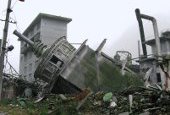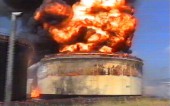
Technological accidents triggered by a natural hazard or disaster which result in consequences involving hazardous substances (e.g. fire, explosion, toxic release) are commonly referred to as Natech accidents. The aim of this database is to systematically collect information on Natech accidents that occured worldwide and allow the searching and analysis of Natech accident reports for lessons-learning purposes.
Suggested Citation
Please use the following reference when citing the database:
eNatech (year of access) eNatech: Natural hazard-triggered technological accidents database, European Commission Joint Research Centre, http://enatech.jrc.ec.europa.eu/
Recent Natech Accidents
| No | Date ▴ | Hazard Type | Natural Hazard | Site | |||
|---|---|---|---|---|---|---|---|
| 1. | 2025/04/04 | Storm | - | Truck transporting chlorine | |||
| 2. | 2024/09/13 | Wild Fire | - | Site 127 | |||
| 3. | 2024/09/07 | Flooding | - | Refinery Salina Cruz Antonio Dovali Jaime PEMEX power station | |||
| 4. | 2024/08/30 | Heavy Rainfall | - | U.S. Yokota Air Base | |||
| 5. | 2024/08/13 | Heat | High temperature | Laundry Blaichach | |||
| 6. | 2024/08/12 | Wild Fire | - | Retail store with construction material | |||
| 7. | 2024/07/25 | Tropical Cyclone | Typhoon Gaemi (or Super Typhoon Carina) | Fuel tanker MT Terranova | |||
| 8. | 2024/04/16 | Heavy Rainfall | - | Bapco, Sitra Tank Farm, Bahrain Petroleum Company |
Recent Publications
- Necci, A. and Krausmann, E. (2022) "Introduction to eNATECH - A user guide", Publications Office of the European Union, Luxembourg, 2022, ISBN 978-92-76-55144-7, doi:10.2760/88277, JRC130281, doi:10.2760/88277.
- Girgin, S., Necci, A. and Krausmann, E. (2019) "Dealing with cascading multi-hazard risks in national risk assessment: The case of Natech accidents", International Journal of Disaster Risk Reduction, 35:101072, doi:10.1016/j.ijdrr.2019.101072.
- Necci, A., Girgin, S. and Krausmann E. (2018) "Understanding Natech Risk Due to Storms: Analysis, Lessons Learned and Recommendations", JRC Technical Report, EUR 29507 EN, doi:10.2760/21366.
About eNatech
 Recent major natural disasters, such as the 2002 summer floods in Europe or Hurricanes Katrina and Rita in the United States in 2005, highlighted the emergence of a new type of risk that manifests itself when the natural and technological worlds collide. The impact of a natural disaster on a facility storing or processing chemical substances can result in the release of hazardous materials with possibly severe off-site consequences through toxic-release, fire or explosion scenarios. Accidents initiated by a natural hazard or disaster which result in the release of hazardous materials are commonly referred to as Natech or na-tech accidents. This includes releases from fixed chemical installations and spills from oil and gas pipelines.
Recent major natural disasters, such as the 2002 summer floods in Europe or Hurricanes Katrina and Rita in the United States in 2005, highlighted the emergence of a new type of risk that manifests itself when the natural and technological worlds collide. The impact of a natural disaster on a facility storing or processing chemical substances can result in the release of hazardous materials with possibly severe off-site consequences through toxic-release, fire or explosion scenarios. Accidents initiated by a natural hazard or disaster which result in the release of hazardous materials are commonly referred to as Natech or na-tech accidents. This includes releases from fixed chemical installations and spills from oil and gas pipelines.
 One of the main problems of Natech accidents is the simultaneous occurrence of a natural disaster and a technological accident, both of which require simultaneous response efforts in a situation in which lifelines needed for disaster mitigation are likely to be unavailable, as they may have been downed by the natural disaster. In addition, hazardous-materials releases may be triggered from single or multiple sources in one installation or at the same time from several hazardous installations in the natural disaster's impact area, requiring emergency-management resources occupied with responding to the natural disaster to be diverted. Moreover, the ongoing climate change predicted to result in an increase of hydro-meteorological events may in turn increase the likelihood of industrial accidents.
One of the main problems of Natech accidents is the simultaneous occurrence of a natural disaster and a technological accident, both of which require simultaneous response efforts in a situation in which lifelines needed for disaster mitigation are likely to be unavailable, as they may have been downed by the natural disaster. In addition, hazardous-materials releases may be triggered from single or multiple sources in one installation or at the same time from several hazardous installations in the natural disaster's impact area, requiring emergency-management resources occupied with responding to the natural disaster to be diverted. Moreover, the ongoing climate change predicted to result in an increase of hydro-meteorological events may in turn increase the likelihood of industrial accidents.
Despite a growing body of research and more stringent regulations for the design and operation of industrial activities, Natech accidents remain a threat. This is partly due to the absence of data and dedicated risk-assessment methodologies and tools. Additional research is therefore needed to better assess the Natech hazard and the vulnerability of industrial facilities to natural hazards, in particular in densely populated and industrialised areas. The analysis of Natech accidents to determine their root causes and accident evolution can provide a significant contribution to the prevention and mitigation of Natech events. The aim of this database is to systematically collect worldwide Natech accidents and allow the searching and analysis of Natech accident reports for lessons-learning purposes.